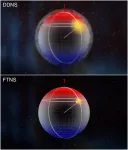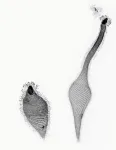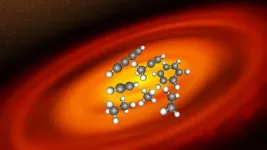(Press-News.org) One of the biggest challenges in quantum technology and quantum sensing is “noise”–seemingly random environmental disturbances that can disrupt the delicate quantum states of qubits, the fundamental units of quantum information. Looking deeper at this issue, JILA Associate Fellow and University of Colorado Boulder Physics Assistant Professor Shuo Sun recently collaborated with Andrés Montoya-Castillo, Assistant Professor of Chemistry, and his team to develop a new method for better understanding and controlling this noise, potentially paving the way for significant advancements in quantum computing, sensing, and control. Their new method, which uses a mathematical technique called a Fourier transform, was published recently in the journal npj Quantum Information.
The Problems with Noise
While some noise sources, like music, can be enjoyable, others, such as the sounds of traffic or a bustling city, can be distracting and even lead to health issues over time. At a microscopic level, noise can pose significant challenges. Even the smallest fluctuations in room temperature or floor vibration, or the qubit system's inherent instability, can disrupt a qubit’s coherence, causing it to lose its quantum state in a process known as decoherence.
“Lots of quantum technologies that people are very excited about, like quantum computers and quantum sensors, face a practical limitation, which is implementation on a larger scale with higher sensitivity,” explains CU Boulder Physics graduate student and co-first author of the paper, Nanako Shitara, who works in Montoya-Castillo’s group. “This is because these quantum systems, or qubits, are very sensitive to fluctuations in the surrounding fields, and they often interact with each other.”
Not only does the noise affect the measurements of fragile systems like an ultra-precise quantum sensor, but it can also make the system less manageable.
Shitara elaborates, “The problem becomes a question of control: you want to control how a qubit reacts to certain kinds of noise. Basically, you want it to react to the right signals very well while it ignores other noise sources.”
Understanding the sources of this noise and finding ways to mitigate it is crucial for developing reliable quantum devices, such as quantum computers or sensors.
“Understanding the noise environment of a qubit is not only important for noise mitigation but also serves as a valuable probe for materials,” Sun explains. “In the latter case, the qubit acts as a sensor, providing insights into the behavior of the surrounding material environment.”
Traditional Noise Characterization
To study and control this noise, scientists have traditionally used a method called Dynamical Decoupling Noise Spectroscopy (DDNS). This method involves applying precise pulses to the qubits and observing how they respond.
“Dynamical decoupling was originally, and still is, used for making the coherence times longer in qubits,” adds Shitara. “It turns out that if you apply very short light pulses onto a qubit, that is interacting with its environment, in some periodic manner, that helps the qubit’s coherence survive longer through some sort of effective decoupling.”
More recently, dynamical decoupling was repurposed as a noise spectroscopy method (hence DDNS) to measure and characterize the noise among the qubits. Though effective, DDNS is complex and requires applying a large number of almost instantaneous laser pulses. It also makes several assumptions about the underlying noise processes, making it cumbersome and less practical for widespread use.
Shitara also elaborated that the DDNS method has minimum and maximum frequency limits for noise spectrum reconstruction due to physical constraints, potentially causing someone to miss interesting phenomena. “You can see that the lowest frequency at which they reconstruct the spectrum can be actually quite high, depending on the implementation,” she adds.
Looking at the challenges of DDNS, Shitara, Sun, Montoya-Castillo, and CU Boulder postdoctoral researcher Arian Vezvaee proposed a new method that required fewer laser pulses and utilized a mathematical technique known as the Fourier transform.
Transforming Noise Maps
The new method, Fourier Transform Noise Spectroscopy (FTNS), offers a straightforward yet powerful way to analyze the noise affecting qubits by focusing on the qubits’ coherence dynamics. Coherence measures how well a qubit maintains its quantum state, which is critical for its performance in quantum computations. These measurements are typically done through simple experiments like Free Induction Decay (FID) or Spin Echo, which start the qubit in a specific initial state and let its coherence decay freely over time, with zero or one intermediate pulses applied during the decay, respectively.
Once these time-based measurements are collected, the data is treated using the Fourier transform. This process is like breaking down a painting into its basic colors to understand what it is made of.
In this paper, the researchers used the Fourier transform to convert the time-domain data into frequency-domain data, effectively breaking down the complex signal into its constituent frequencies. By doing so, FTNS revealed the noise spectrum, showing which noise frequencies were present and how strong they were. The researchers found that the FTNS method also handled various types of noise, including complex noise patterns that were challenging for other methods like DDNS to decipher.
While a more streamlined method, FTNS has some limitations, like minimum and maximum frequency constraints and the need for high-resolution time and coherence measurements. However, the researchers demonstrated that these limitations are far less constraining than DDNS's.
Sun and his team at JILA are now experimentally testing the FTNS method in nitrogen-vacancy centers, often found within diamonds used as qubits. Simultaneously, Joe Zadrozny, Associate Professor of Chemistry at Ohio State University, and his team are working to implement FTNS in molecular qubits and magnets.
“We are super excited about our method's ability to reveal the frequency-resolved conversation between a qubit or sensor and its environment—and even more about the new opportunities it offers,” elaborated Montoya-Castillo. “From the sensing perspective, we are working to establish how FTNS can show hard-to-see physical processes near a sensor, whether this is a color center in a crystal, like nitrogen vacancies in diamond, trapped ions, or molecular magnets. This is an exciting frontier as quantum sensors may enable imaging of complex biological processes, like protein folding, with unprecedented detail and temporal resolution."
This research was funded by several grants from the National Science Foundation as well as the Sloan Research Fellowship.
END
Mapping noise to improve quantum measurements
2024-06-06
ELSE PRESS RELEASES FROM THIS DATE:
Tiny predator owes its shape-shifting ability to “origami-like” cellular architecture
2024-06-06
For a tiny hunter of the microbial world that relies on extending its neck up to 30 times its body length to release its deadly attack, intricate origami-like cellular geometry is key. This geometry enables the rapid hyperextensibility of the neck-like protrusion, for single-celled predator Lacrymaria olor, a new study reports. The findings not only explain L. olor’s extreme shape-shifting ability but also hold potential for inspiring innovations in soft-matter engineering or the design of robotic systems. Single-celled protists are well known for their ability to perform dynamic morphological changes in ...
Widespread use of high-assay low-enriched uranium raises significant nuclear security concerns
2024-06-06
In a Policy Forum, R. Scott Kemp and colleagues argue that promoting new nuclear reactor technologies using high-assay low-enriched uranium (HALEU) threatens the international system of controls that has prevented nuclear weapons proliferation for over 30 years. “Governments and others promoting the use of HALEU have not carefully considered the potential proliferation and terrorism risks that the wide adoption of this fuel creates,” write Kemp et al. The authors warn that if HALEU becomes a standard reactor ...
JWST uncovers features of very-low-mass star’s protoplanetary disk that influence planet composition
2024-06-06
James Webb Space Telescope (JWST) observations have revealed abundant hydrocarbons in the protoplanetary disk surrounding a young, very-low-mass star – findings that provide novel insights into the chemical environment from which many terrestrial planets, in particular, are born. Planets form in disks of gas and dust that orbit young stars. Observations show that terrestrial planets form more efficiently than gas giant planets around very-low-mass stars (VLMSs) – those with less than 0.3 solar masses. Although the chemical compositions of the inner disk regions around higher mass stars ...
Mammalian adipose tissue thermogenesis evolved in eutherian mammals
2024-06-06
Heat production in fat tissue, a trait also known as adipose tissue thermogenesis, evolved over two stages in mammals, fully developing in eutherian mammals after the group’s evolutionary divergence from marsupials, according to a new study. The results could provide insights that inform future therapies related to metabolism and obesity. Many organisms produce heat internally to regulate body temperature. It is thought that the evolution of the ability to maintain high body temperatures provided ...
The first example of cellular origami
2024-06-06
“There are some things in life you can watch and then never unwatch,” said Manu Prakash, associate professor of bioengineering at Stanford University, calling up a video of his latest fascination, the single-cell organism Lacrymaria olor, a free-living protist he stumbled upon playing with his paper Foldscope. “It’s … just … it’s mesmerizing.”
“From the minute Manu showed it to me, I have just been transfixed by this cell,” said Eliott Flaum, a graduate student ...
Planet-forming disks around very low-mass stars are different
2024-06-06
Planets form in disks of gas and dust, orbiting young stars. The MIRI Mid-INfrared Disk Survey (MINDS), led by Thomas Henning from the Max Planck Institute for Astronomy (MPIA) in Heidelberg, Germany, aims to establish a representative disk sample. By exploring their chemistry and physical properties with MIRI (Mid-Infrared Instrument) on board the James Webb Space Telescope (JWST), the collaboration links those disks to the properties of planets potentially forming there. In a new study, a team of researchers ...
Researchers identify key differences in inner workings of immune cells
2024-06-06
From the outside, most T cells look the same: small and spherical. Now, a team of researchers led by Berend Snijder from the Institute of Molecular Systems Biology at ETH Zurich has taken a closer look inside these cells using advanced techniques. Their findings show that the subcellular spatial organisation of cytotoxic T cells – which Snijder refers to as their cellular architecture – has a major influence on their fate.
Characteristics that determine a cell’s fate
When cells with nuclear invaginations encounter a pathogen, they turn into powerful effector cells that rapidly proliferate and kill the pathogen. Their fellow ...
Molecular pathway that impacts pancreatic cancer progression and response to treatment detailed
2024-06-06
CHAPEL HILL, North Carolina – Researchers at UNC Lineberger Comprehensive Cancer Center and colleagues have established the most comprehensive molecular portrait of the workings of KRAS, a key cancer-causing gene or "oncogene," and how its activities impact pancreatic cancer outcomes. Their findings could help to better inform treatment options for pancreatic cancer, which is the third leading cause of all cancer deaths in the United States.
The research was published as two separate articles in Science.
“Because ...
Ferroelectric material is now fatigue-free
2024-06-06
Researchers at the Ningbo Institute of Materials Technology and Engineering (NIMTE) of the Chinese Academy of Sciences, in collaboration with research groups from the University of Electronic Science and Technology of China and Fudan University, have developed a fatigue-free ferroelectric material based on sliding ferroelectricity.
The study was published in Science.
Ferroelectric materials have switchable spontaneous polarization that can be reversed by an external electric field, which have been widely applied to non-volatile memory, sensing, and ...
Marsupials key to discovering the origin of heater organs in mammals
2024-06-06
Around 100 million years ago, a remarkable evolutionary shift allowed placental mammals to diversify and conquer many cold regions of our planet. New research from Stockholm University shows that the typical mammalian heater organ, brown fat, evolved exclusively in modern placental mammals.
In collaboration with the Helmholtz Munich and the Natural History Museum Berlin in Germany, and the University of East Anglia in the U.K., the Stockholm research team demonstrated that marsupials, our distant relatives, possess a not fully evolved form of brown fat. They discovered that the pivotal heat-producing protein called ...






